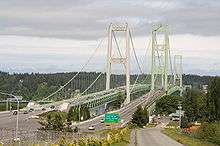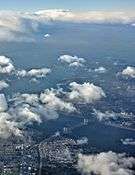Tacoma Narrows Bridge
| Tacoma Narrows Bridge | |
|---|---|
 The bridges in 2009, as seen from the Tacoma side. | |
| Coordinates | 47°16′5″N 122°33′2″W / 47.26806°N 122.55056°WCoordinates: 47°16′5″N 122°33′2″W / 47.26806°N 122.55056°W |
| Carries |
8 lanes of |
| Crosses | Tacoma Narrows |
| Locale | Tacoma to the Kitsap Peninsula United States |
| Maintained by | Washington State Department of Transportation |
| Characteristics | |
| Design | Twin Suspension |
| Total length | 5,400 ft (1,645.92 m)[1] |
| Longest span | 2,800 ft (853.44 m)[1] |
| Clearance below | 187.5 ft (57.15 m) |
| History | |
| Opened |
October 14, 1950 (westbound) July 15, 2007 (eastbound) |
| Statistics | |
| Toll |
Eastbound only (passenger car): $6.00 (cash/credit price) $5.00 (transponder price) $7.00 (pay by mail) |
 | |
The Tacoma Narrows Bridge is a pair of twin suspension bridges that span the Tacoma Narrows strait of Puget Sound in Pierce County, Washington. The bridges connect the city of Tacoma with the Kitsap Peninsula and carry State Route 16 (known as Primary State Highway 14 until 1964) over the strait. Historically, the name "Tacoma Narrows Bridge" has applied to the original bridge nicknamed "Galloping Gertie", which opened in July 1940, but collapsed because of aeroelastic flutter four months later, as well as the replacement of the original bridge which opened in 1950 and still stands today as the westbound lanes of the present-day twin bridge complex.
The original Tacoma Narrows Bridge opened on July 1, 1940. It received its nickname "Galloping Gertie" because of the vertical movement of the deck observed by construction workers during windy conditions. The bridge became known for its pitching deck, and collapsed into Puget Sound the morning of November 7, 1940, under high wind conditions. Engineering issues as well as the United States' involvement in World War II postponed plans to replace the bridge for several years; the replacement bridge was opened on October 14, 1950.
By 1990, population growth and development on the Kitsap Peninsula caused traffic on the bridge to exceed its design capacity; as a result, in 1998 Washington voters approved a measure to support building a parallel bridge. After a series of protests and court battles, construction began in 2002 and the new bridge opened to carry eastbound traffic on July 15, 2007, while the 1950 bridge was reconfigured to carry westbound traffic.
At the time of their construction, both the 1940 and 1950 bridges were the third-longest suspension bridges in the world in terms of main span length, behind the Golden Gate Bridge and George Washington Bridge. The 1950 and 2007 bridges are now the fifth-longest suspension bridge spans in the United States, and the 38th-longest in the world.
Tolls were charged on the bridge for the entire four-month service life of the original span, as well as the first 15 years of the 1950 bridge. In 1965, the bridge's construction bonds plus interest were paid off, and the state ceased toll collection on the bridge. Over 40 years later, tolls were reinstated as part of the financing of the twin span, and are presently collected only from vehicles traveling eastbound.
Original bridge


The desire for the construction of a bridge in this location dates back to 1889 with a Northern Pacific Railway proposal for a trestle, but concerted efforts began in the mid-1920s. In 1937, the Washington State legislature created the Washington State Toll Bridge Authority and appropriated $5,000 to study the request by Tacoma and Pierce County for a bridge over the Narrows. The bridge was designed by Leon Moisseiff.
The first Tacoma Narrows Bridge opened to traffic on July 1, 1940. Its main span collapsed into the Tacoma Narrows four months later on November 7, 1940, at 11:00 a.m. (Pacific time) as a result of aeroelastic flutter caused by a 42 mph (68 km/h) wind. The bridge collapse had lasting effects on science and engineering. In many undergraduate physics texts the event is presented as an example of elementary forced resonance, with the wind providing an external periodic frequency that matched the natural structural frequency, even though the real cause of the bridge's failure was aeroelastic flutter. A contributing factor was its solid sides, not allowing wind to pass through the bridge's deck. Thus, its design allowed the bridge to catch the wind and sway, which ultimately took it down.[2] Its failure also boosted research in the field of bridge aerodynamics and aeroelastics, fields which have influenced the designs of all the world's great long-span bridges built since 1940.
No human life was lost in the collapse of the bridge. The only fatality was a Cocker Spaniel named Tubby, who perished after he was abandoned in a car on the bridge by its owner, Leonard Coatsworth. Professor Frederick Burt Farquharson, an engineer from the University of Washington who had been involved in the design of the bridge, tried to rescue Tubby, but was bitten by the terrified dog when he attempted to remove him. The collapse of the bridge was recorded on 16 mm film by Barney Elliott, owner of a local camera shop, and shows Farquharson leaving the bridge after trying to rescue Tubby and making observations in the middle of the bridge. In 1998, The Tacoma Narrows Bridge Collapse was selected for preservation in the United States National Film Registry by the Library of Congress as being "culturally, historically, or aesthetically significant".[3] This footage is still shown to engineering, architecture, and physics students as a cautionary tale.
Dismantling of the towers and side spans—having survived the collapse of the main span, but being damaged beyond repair—began shortly after the collapse and continued into May 1943. The United States' participation in World War II, as well as engineering and finance issues, delayed plans to replace the bridge.
Westbound bridge
The current westbound bridge was designed and rebuilt with open trusses, stiffening struts and openings in the roadway to let wind through. It opened on October 14, 1950, and is 5,979 feet (1822 m) long — 40 feet (12 m) longer than the first bridge, Galloping Gertie. Local residents nicknamed the new bridge Sturdy Gertie, as the oscillations that plagued the previous design had been eliminated. This bridge along with its new parallel eastbound bridge are currently the fifth-longest suspension bridges in the United States.
When built, the westbound bridge was the third longest suspension bridge span in the world.[4] Like other modern suspension bridges, the westbound bridge was built with steel plates that feature sharp entry edges rather than the flat plate sides used in the original Tacoma Narrows Bridge (see the suspension bridge article for an example).
The bridge was designed to handle 60,000 vehicles a day. It carried both westbound and eastbound traffic until the eastbound bridge opened on July 15, 2007.[5]
Eastbound bridge
In 1998, voters in several Washington counties approved an advisory measure to create a second Narrows span. Construction of the new span, which carries eastbound traffic parallel to the current bridge, began on October 4, 2002, and was completed in July 2007. The Washington State Department of Transportation collects a toll before entering the eastbound span, at $5.00 for "Good to Go" account holders with in-vehicle transponders, and a $6.00 toll for cash/credit card customers. The existing span had been free of tolls since 1965. The new bridge marks the first installation of the new Good To Go electronic toll collection system.

See also
Gallery
- New bridge sections used in construction of the new span.
 A panorama of Tacoma Narrows Bridge in 2007.
A panorama of Tacoma Narrows Bridge in 2007. The westbound bridge, in 1988, when it carried traffic in both directions
The westbound bridge, in 1988, when it carried traffic in both directions Both bridges during the 2007 bridge's grand opening ceremony, as seen from the top of the westbound bridge.
Both bridges during the 2007 bridge's grand opening ceremony, as seen from the top of the westbound bridge. Aerial view, 2016
Aerial view, 2016 Aerial view, 2017
Aerial view, 2017
References
- Notes
- 1 2 Tacoma Narrows Bridge at Structurae
- ↑ Billah, K.; R. Scanlan (1991). "Resonance, Tacoma Narrows Bridge Failure, and Undergraduate Physics Textbooks" (PDF). American Journal of Physics. 59 (2): 118–124. Bibcode:1991AmJPh..59..118B. doi:10.1119/1.16590.
- ↑ "Complete National Film Registry Listing - National Film Preservation Board". The Library of Congress. Retrieved 2016-11-21.
- ↑ Holstine, Craig E. (2005). Spanning Washington : historic highway bridges of the Evergreen State. Washington State University Press. pp. 61–62. ISBN 0-87422-281-8.
- ↑ Beekman, Dan and Santos, Melissa; "First traffic crosses new bridge"; The News Tribune; July 16, 2007
Further reading
- Historical
- Timeline of the bridges
- Tacoma Narrows Bridge
- Schagler, N. (1995). Failed Technology: True Stories of Technological Disasters. New York: UXL. ISBN 978-0-8103-9796-5
- Tacoma Narrows Bridge - University of Washington Library
- Second span project
- Tacoma Narrows Bridge Project (WS DOT Web Page; information about the new bridge construction project)
- Puget Sound Transportation projects:Tacoma Narrows Bridge (unofficial site providing news, photos and information about the second span construction)
- Wind Tunnel Testing Summary from the National Research Council of Canada
- Wind Tunnel Testing Press Release from the National Research Council of Canada
- "Bridge Workers are Walking Tall Above the Narrows", Rob Carson (The News Tribune), Kitsap Sun, September 25, 2005
- Wire by wire, Tacoma Narrows bridge is built Mike Lindblom, The Seattle Times, October 15, 2005
External links
| Wikimedia Commons has media related to Tacoma Narrows Bridges. |
- Photos of the bridge and the new span under construction
- Photos of the bridge and contractor details
- Tacoma Narrows Bridge (1940) at Structurae
- Tacoma Narrows Bridge (1950) at Structurae
- New Tacoma Narrows Bridge (2007) at Structurae